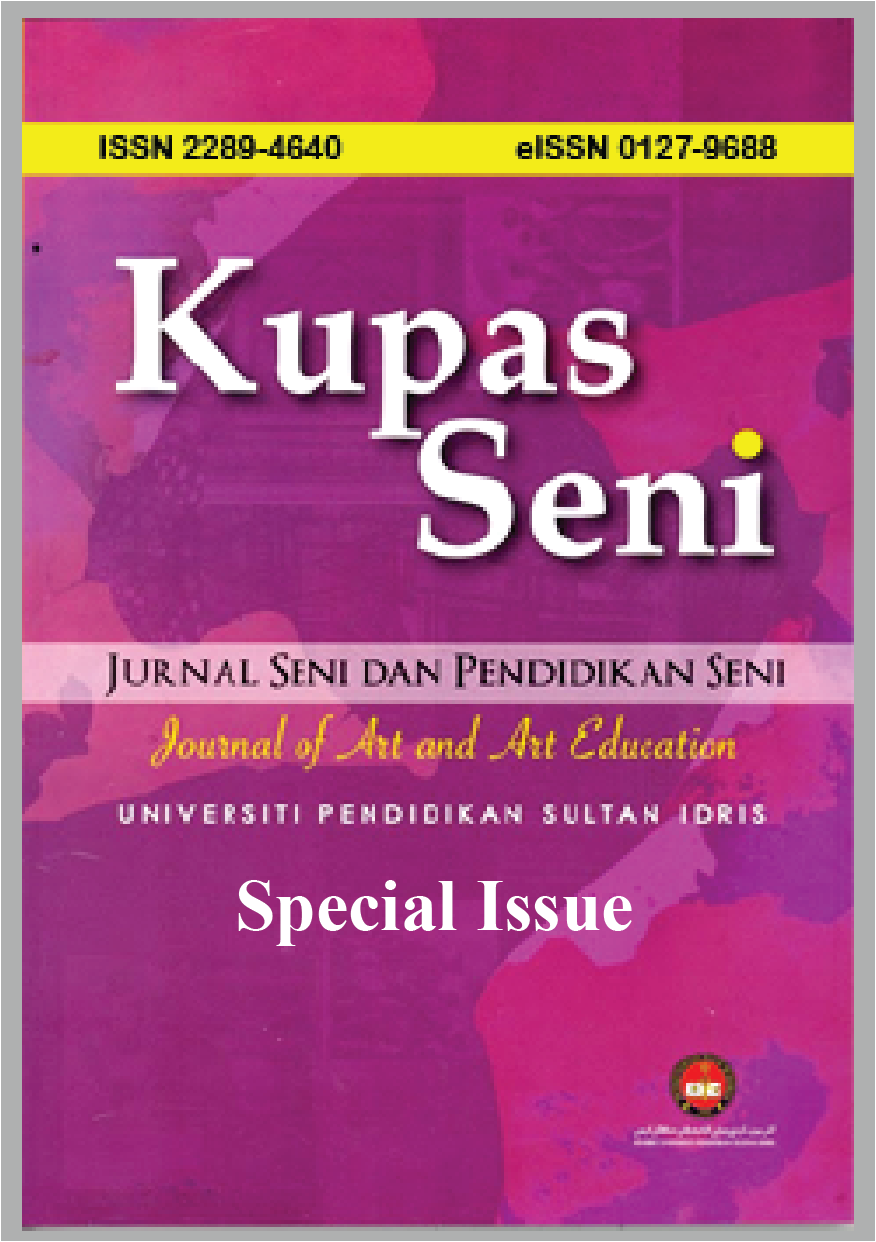The Influence of Cultural Diversity on the Art of Mosque Design in Asian Countries
DOI:
https://doi.org/10.37134/kupasseni.vol10.sp.2.5.2022Keywords:
Influence, Cultural Diversity, Design, Mosque, AsianAbstract
A mosque is a place of worship for Muslims all over the world. A mosque is also a place to perform worship activities to gain the pleasure of Allah SWT. This study examines the influence of culture on the design of mosques in neighbouring Asian countries using qualitative descriptive methods and analyses the comparison of selected mosques. The focus is more on comparing the motifs, mimbar, and mihrab of mosques in selected Asian countries, such as Shah Alam Great Mosque, Panglima Kinta Mosque, Ipoh, and Tonson Mosque in Thailand using semiotics theory. The findings of the study found that local factors based on local lifestyle, urban development, local policies, local beliefs, local culture, and external factors such as foreign policy, national commercial policy, and foreign policy cause differences from the motifs found in the architecture of mosques. The history of the establishment of mosques in an area also influences the production of different mosque architecture. Among them, trade activities from foreign countries, such as Hindu-Buddhists and Christians, have influenced the production of motifs in mosque architecture. The use of motifs in mosque architecture carries a symbolic meaning based on cultural characteristics and ways of life closely related to the soul of the local population and brings the manifestation of art and Islam. This study proves that the manifestation of traditional jewellery does play an important role not only in spreading the symbolic meaning but also in representing the history, beliefs, and background of the local Malays.
Downloads
References
Agar, M. (1980). Stories, background knowledge and themes: Problems in the analysis of life history narrative. American Ethnologist, 7(2), 223-239.
Creswell, J. W. (2014). Qualitative, quantitative, and mixed methods approach. Sage.
Creswell, J. W. (2009). Mapping the field of mixed methods research. Journal of mixed methods research, 3(2), 95-108.
Ernawati, R. N. (2020). Penerapan Bentuk Bunga Lotus Dalam Tropical Bomber (Doctoral
dissertation, ISI Yogyakarta).
Erzen, J. N. (2011). Reading mosques: Meaning and architecture in Islam. The Journal of
Aesthetics and Art Criticism, 69(1), 125-131.
Gazalba, S. (1983). Mesjid, pusat ibadat dan kebudayaan Islam. Pustaka Antara.
Hussin, R., Mokhtar, A., & Jabbar, A. R. A. (2017). Seni kaligrafi (khat) di mihrab masjid-masjid negeri Malaysia dan hubungannya dengan seni visual. KUPAS SENI, 5, 1-13.
Kahera, A. I., Abdulmalik, L., & Anz, C. (2009). Design Criteria for Mosques and Islamic
Centres: Art, Architecture, and Worship. Routledge.
Kurniawan, S. (2014). Masjid dalam lintasan sejarah umat islam. Jurnal Khatulistiwa-Journal of Islamic Studies, 4(2), 169-184.
Jacob, E. (1987). Qualitative research traditions: A review. Review of educational research, 57(1), 1-50.
Mariani, N. (2021). Upaya Meningkatan Nilai Estetika Pembelajaran Pendidikan Agama Islam Melalui Seni Budaya. GUAU: Jurnal Pendidikan Profesi Guru Agama Islam, 1(1), 2332.
Mat, K. A. K., Haron, M. S., Yaacob, S. E., & Hassan, W. Z. W. (2021). Sejarah Kemasukan Islam Di Bangkok. Jurnal Dunia Pengurusan, 3(1), 125-131.
Merriam, S. B. (1998). Qualitative Research and Case Study Applications in Education. Revised and expanded from" Case Study Research in Education.". Jossey-Bass Publishers, 350 Sansome St, San Francisco, CA 94104.
Nafiah, S. F. D. A. (2021). Kesenian Tamadun Islam dalam Warisan Seni Tradisi Melayu [Art of Islamic Civilazation in the Malay Heritage Art Tradition]. BITARA International Journal of Civilizational Studies and Human Sciences (e-ISSN: 2600-9080), 4(2), 162-167.
Nazhar, R. D. (2016). KAJIAN MAKNA: MIHRAB MASJID KONTEMPORER AL-IRSYAD KOTA BARU PARAHYANGAN. Serat Rupa Journal of Design, 1(2), 292-305.
Noor, M. Z. M., & Rozali, E. A. (2021). Arabesque dalam Karya Seni Ukiran Melayu: Kesinambungan Kegemilangan Tamadun Islam [Arabesque in the Malay Carving Art: The Glorious Continuation of the Islamic Civilization]. BITARA International Journal of Civilizational Studies and Human Sciences (e-ISSN: 2600-9080), 4(1), 118-129.
Pradana, R. W. (2020). Bentuk dan Makna Simbolik Ragam Hias Pada Masjid Sunan Giri.
SPACE, 7(1).
Pradisa, A. P. S. (2017). Perpaduan Budaya Islam dan Hindu dalam Masjid Menara Kudus. In Prosiding Seminar Heritage IPLBI (pp. A213-A218).
Saefullah, A. (2018). Masjid kasunyatan banten: tinjauan sejarah dan arsitektur. Jurnal Lektur Keagamaan, 16(1), 127-158.
Santoso, M., Hopke, P. K., & Hidayat, A. (2008). Sources identification of the atmospheric aerosol at urban and suburban sites in Indonesia by positive matrix factorization. Science of the Total Environment, 397(1-3), 229-237.
Sulaiman, H. (2017). Kecerdasan emosi menurut al-Quran dan al-Sunnah: Aplikasinya dalam membentuk akhlak remaja. O-JIE: Online Journal of Islamic Education, 1(2).
Supatmo, S. (2016). Keragaman Seni Hias Bangunan Bersejarah Masjid Agung Demak. Imajinasi: Jurnal Seni, 10(2), 107-120.
Waijittragum, P. (2012, November). A Trace of Islamic Art in Thai Mosques. In roceedings of World Academy of Science, Engineering, and Technology (No. 71, p. 1186). World Academy of Science, Engineering, and Technology (WASET).
Yusof, N. A., Haron, H., & Mutalib, N. A. (2014). Malacca Mosque: The Aesthetics of Old
Mosques in Malaysia. Mediterranean Journal of Social Sciences, 5(27 P3), 1342.
Zaki, Y. (1978). Allah and Eternity: Mosques, Madrasas and Tombs. Architecture of the Islamic World, London: Thames and Hudson, 15-40.
Downloads
Published
Issue
Section
License
Copyright (c) 2022 Muhammad Salehuddin Zakaria, Hairulnisak Merman, Muhammad Fikri Saidi Othman

This work is licensed under a Creative Commons Attribution-NonCommercial-ShareAlike 4.0 International License.





